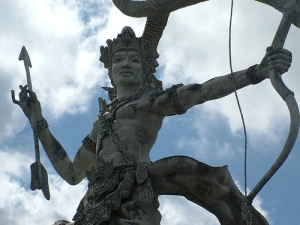Desire, Procure, Digest, Absorb and Release
Our digestive tract is a long, sensitive, and undulating tube, from mouth to anus, through which our most inner-self relates and interfaces with our environment. Our digestive tract forms a soft and spiralic support of the spine. Embodiment of the digestive tract is important in yoga practice. It keeps our movements soft as well as strong. It gives us deeper awareness and brings more of who we are to the forefront in our movement practice. Embodying the digestive tract gives us access to our deepest yearnings and desires.
Through the digestive tract we are invited to become aware of the intensity of our primal desires. Through this recognition and allowance we can release many inhibitions that we have inadvertently placed on our life force by trying to limit and squash what can be an almost overwhelming sensation of desire. When we begin to allow our desire it is no longer overwhelming, but awe-inspiring. A deep softening results from the tremendous release of struggle when we are able to experience this vast force and embrace it. We spontaneously begin to witness that love is the motivating force behind desire. We recognize in ourselves how this commingling of desire and love is the motivating force in our existence.
The mouth to anus pathway is one continuous channel with varying qualities and functions that work together to procure nutrients and nurturance and eliminate waste.
DIGESTION IS AN INTIMATE ACT
The digestive tract is a profound and seamless way that we interface to our environment. We literally take in and absorb what we chose from the outer world. In health our digestion provides inner support and produces feelings of self-comfort and nurturance. When our digestive tract is healthy we feel that we can ask for, procure, and receive the nurturance that we need. We innately know that we have choices all along the way. We feel the process of accepting, digesting, absorbing and releasing as a comfortable and satisfying experience. The phases for obtaining the nutrients from our food are felt and enjoyed. In fact, this is probably one of the most sensual processes of our life and we are fully engaged in it daily.
Following the pathway of our digestive tract we learn about many of our inner choices. We have the opportunity to visit them intimately and observe their arising. The observation process gives us the space to witness the choices we make. We may find that some of them are no longer in our best interest. We gain the opportunity to make new choices if we like.
The investigation well might begin with what we decide to put in our mouths in the first place. How aware are we of what we eat? Do we eat what we know to be nourishing and health giving? If not, how does that feel as we take the substance further into ourselves and begin to digest and assimilate? What we eat is important. How do we feel about what we eat? Good food is essential and good food is not the same for everyone. These are important questions to answer.
We also need to consider the choices we are making just below the surface of our conscious awareness. The expression of consciousness and the processes of digesting and absorbing are different at the various places along the tube. The central organizing region of the digestive tract is the manipura chakra area. The manipura chakra is the fire center in the body. Is the fire of your digestion balanced? Manipura area also holds consciousness of “me”, what is mine, what I want, and what I don’t want. What am I willing to take in – from food and from life? The digestive tube wends and winds its way, with the small intestine tethered by the mesentery in the back abdominal wall. The main absorption of nutrients from food and life takes place here in the small intestinal region. How is your digestion? Are you able to accept life as it is, take nourishment from it, and release what doesn’t feed you?
Mouth is about desire. Are you able to search for, find, take in, and receive with your mouth? Where do you feel satisfaction? Where do you detect discomfort? Drop into these feelings and explore. You will find that your personality expresses through you, and you will also realize the underlying humanity and universality that lives in the digestive organs.
STRUCTURAL SUPPORT
The digestive tube provides our spiralic support of core. This is soft core. The qualities of health that we experience along the tract will reflect in the quality of support along our vertical axis and the spine. Healthy tone in the digestive tract is both physical and psycho-emotional. A happy and well functioning digestive tube will feel good and will naturally support the spine. An unhealthy tract will not do such a good job. Following and observing these organs as they function will give good insight into how to heal and balance this process.
Structurally, we look for support through the cave of the mouth, nasal passages, the tongue, and the hyoid bone. The esophagus is a tremendous support for the cervical spine and down through the thoracic spine. The spirals and tone of the organs in the torso support the lumbar region and give us depth and volume. The ascending and descending large intestines give us verticality on the left and right pillars of the torso and ground the pelvic halves into the earth. The transverse colon gives us a channel of movement that sweeps horizontally through the upper torso just under the liver. The sigmoid colon and the rectum root us again through center, supporting the sacrum and releasing through the anus.

WE HAVE MANY OPPORTUNITIES TO SAY “YES” OR “NO” TO WHAT WE CONSUME
In embodying the digestive tract one of the things we notice is that there are so many different places along the route for us to accept or reject what we consume. We can close our mouths and basically say “no” to something. If it is already in our mouth we can spit it out. Our throat can close or our esophagus can tighten. The opening between the esophagus and the stomach can reject and close up. If we have already swallowed we can still vomit.
These places of choice are numerous within the digestive tube:
• Lips
• Mouth
• Throat
• Esophagus
• Cardiac sphincter
• Pyloric sphincter
• Duodenal-jejunal flexure
• Small Intestine
• Iliocecal valve
• Large Intestine
• Rectum
• Anus
WHAT ARE THE ORGANS OF DIGESTIVE TRACT AND WHAT DO THEY DO?
The nose and mouth search for our food. When we are very young the rooting reflex helps us to locate the nipple. We use our mouth to grab the nipple and suck the milk into us. This is a life or death desire that is centered in the mouth and through the navel. As the baby nurses and the warm milk moves through the mouth, esophagus and into the stomach the sucking and drawing of the nursing action produces satisfaction and tones the digestive tract.
When we are older we use our limbs to bring the food to our mouths.
We smell, taste, salivate, chew, and mash our food with our tongues. Our tongues flip the food into the fibromuscular pharynx for swallowing.
We swallow through the esophagus and the food is transported via peristaltic contractions to the gastro-esophageal junction (the cardia sphincter) and into the stomach.
The stomach is a j-shaped hollow organ that stores, churns and digests food. It produces gastric juices, including digestive enzymes and hydrochloric acid – which also kills potentially harmful microbes. The stomach is the widest place in the digestive tract. There is a sphincter at the inlet (cardia sphincter) and the outlet (pyloric sphincter) of the stomach. The cardia sphincter relaxes with swallowing and the pyloric sphincter squirts partially digested food into the duodenum.
The stomach, a hollow organ when empty, is something like a funnel into the rest of the digestive tract. The pyloric sphincter is small and selective. The stomach contents can be quite full for some time before we actually take anything into the small intestines for absorption. The mechanical action of the stomach is very strong and its own acids are dangerous to itself without the right mucus lining. The muscles of the stomach individuate very well and can compartmentalize its contents and allow different processes to go on in different aspects of the organ.
The stomach has 3 primary layers.
Mucosa: The innermost layer has deep folds, called gastric pits, which contain the gastric glands. Mucus cells in the upper part of each pit secrete mucus lining to keep the stomach from digesting itself. The stomach produces up to 5 pints of gastric juices a day.
Submucosa: The fibrous and vascular layer between the mucosa and the muscular layers.
Muscularis: Three layers of smooth muscle – longitudinal, circular and oblique.
The Serosa is the outermost protective layer.
When food is liquefied the stomach begins to move its partially digested contents and juices toward the pyloric sphincter. The pyloric sphincter is the outlet to the duodenum. Approximately 3-4 hours after eating the pyloric sphincter opens at intervals and the stomach squirts its contents into the duodenum, about a teaspoon at a time.
The duodenum receives more digestive juices from the pancreas and gallbladder. The duodenum is a transition between the highly mechanical digestion of the stomach and the absorption of the small intestines. Many more digestive juices are applied to the food here and some of the strongest acids from the stomach are neutralized. Bile from the liver is stored in the gallbladder and the gallbladder squirts the bile into the duodenum to aid in the digestion of fat. Pancreas produces about 1.5 liters of digestive juices a day and they flow into the duodenum. Pancreatic juices include alkalis that neutralize stomach acids and about 15 enzymes that work on digesting carbohydrates, proteins and fat.
The upper portion of the digestive tract transports food to the stomach and mechanically breaks it down. The mouth and teeth mash and grind, the stomach churns and secretes powerful digestive juices. In the duodenum the liver and pancreas become involved with further digestive fluids and enzymes. By the time the food is ready to leave the duodenum a lot has been done.
Small Intestines
At the duodenal-jejunal flexure the small intestines begin. Pancreatic juices, bile and the intestines own secretions, further break down the food.
The small intestine has 4 layers like the stomach with an outer protective layer.
Mucosa: Composed of ring like folds that are covered by tiny finger like projections called villi.
Villi: Each villi is covered with epithelium – a cell layer that allows digested nutrients to move into the interior. From there the nutrients pass into the slowly flowing lymph and blood. Those that pass into the blood are carried to the liver. Those that are too large to enter the blood vessels are carried away in the lymph and to the heart. The folds and villi system increase the surface area of the small intestines more than 500 times over what a flat lining would provide.
Submucosa: A loose layer carrying vessels and nerves.
Muscular: Outer longitudinal and inner circular smooth muscle fibers. The small intestine propels its contents via segmentation – a series of ring like contractions – and peristalsis – small wave like movements.
The Serosa is outer protective layer.
The small intestines continue the chemical and mechanical digestive process. They do almost all of the absorptive process of the entire gastrointestinal tract. At the end of this amazingly long and convoluted tube is the ileocecal valve that leads to the cecum section of the ascending colon.
The ileocecal valve is a place of major transition. The absorptive process is mostly over. The small intestine is finished and ready (or not) to release its contents through a rather narrow passage – the ileocecal valve – into the relatively wide receiving room of the cecum. The appendix is very near this valve in the lower ascending colon.
The appendix is a reservoir of friendly bacteria that can be used to replenish the digestive tract when necessary.
The Large Intestine is about transporting waste. It absorbs water, some vitamins and minerals and secretes mucus. The lining of the large intestine is without villi. The large intestine consist of the ascending, transverse, descending, and sigmoid colons, the rectum, the anal canal and sphincters, and the appendix. The appendix may be a reservoir of healthy bacteria for the intestinal tract in case of dysentery.







